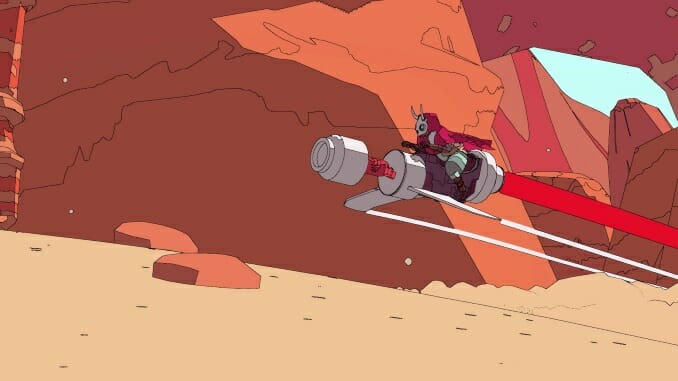Sable Carries the Melancholic and Joyful Weight of Living

The first thing that struck me about Sable is the light. Its desert can bloom in color, but it is willing to make itself dim until there is only one shade, until the only thing that creates depth is the texture of stone and metal. Sable plays with its light. Old spaceships hum with the artificiality of steel. Ancient ruins burst into color with the dawn and fade into shadow with the night. Forests of stone swallow your senses, make the wide world into a thin maze. Though much of Sable’s world of Midden is old and dead, it still feels alive. It is still in the process of becoming. As the wind erodes sandstone, as footsteps alter the shape of the mountains, we can make something else out of ancient cataclysms. Everything is both old and new.
Fittingly, Sable’s title comes from the protagonist’s name, not her role or the place she lives. It foreshadows the game’s small stakes. Sable is a Glider. Just now coming of age, she leaves her home to discover who she might become and what role she might play. To begin, Sable wears the mask of her culture, made from an Ibex skull. As Sable helps other people, she gets badges, which she can turn in for other masks. For example, she could take the mask of the mechanist becoming an expert on refashioning the ancient machinery around her into something practical. She could become a Climber, exploring the highest margins of the world. She could become something as yet unnamed or unanticipated. Its openness means that Sable makes very few demands of you. In a real sense, everything is optional. Because of that, it actually feels free. It is not the freedom to move through space uninhibited, to dominate or control. Rather it is the freedom to determine who you are, to let the people around you make you into something new.
Superficially, it can feel as if Sable is chasing the prestige of games with far larger budgets. Breath of the Wild is an obvious influence, and for all that game’s virtues, it still carries the ideological background of “the open world.” In Sable, though, there are no kingdoms to save or cities to conquer, just a child’s future to determine. It deftly avoids the traps of “open world” games even as it uses some of their vocabulary. Yes, you will climb large structures to survey and fill in your map, but to do so you must purchase that map from a cartographer. You cannot survey the world on your own; you need someone else’s expertise. Yes, you can get a faster speeder bike or train yourself to climb longer. However, neither of those boons facilitate much more than convenience, and you still need the help of mechanics or mystics for you to get them. Most pointedly, there are no enemies or combat. There are no museums to place old artifacts, nor colonizers to steal them back from. There are divisions, but there are no nations, no borders. Thematic threads like these affirm that you are still part of a larger community, one that you continually rely on even as you are alone.
That communal portrait is a consequence of Sable’s apocalyptic optimism. As I’ve gestured at, the world is full of dead things. You’ll find ravaged spaceships on cliffsides, pipes and shrapnel thrown across the landscape. What population centers exist are small: a city with dozens of inhabitants and waystations with a handful. Most of the structures that dot the landscape are long abandoned, overtaken by nature or decaying in the sun. While Sable is decidedly without violent conflict, the signs of its previous existence are everywhere. The metal ships had to come from somewhere. They imply a far-flung militaristic or corporate structure. Now, those things are long gone, and the material they left behind is used to make something new. As she helps Sable construct it, one of her teachers explains that Sable’s speeder bike was meant to be. The art is somewhere in metal, you just need to get it out. However, you get all the pieces for the bike from old machines that once served a very different purpose. The materials of the world are refashioned, shaped into what they were meant to be: an aid, a shared communal joy. Furthermore, though technology is advanced, it is also sparse. The barren natural world still thrives. The game offers no opportunity for you to destroy it. One wonders what the difference between natural and artificial is when old cliffs share the world with older spaceships. Sable’s world is not a utopia. There are inequalities and injustices. However, though Midden shows innumerable signs of death and apocalypse, life remains. It goes on living in a way unimaginable to what came before. Sable is a videogame that seeks to look beyond itself, its own means of production, to imagine a world that exists without those things.